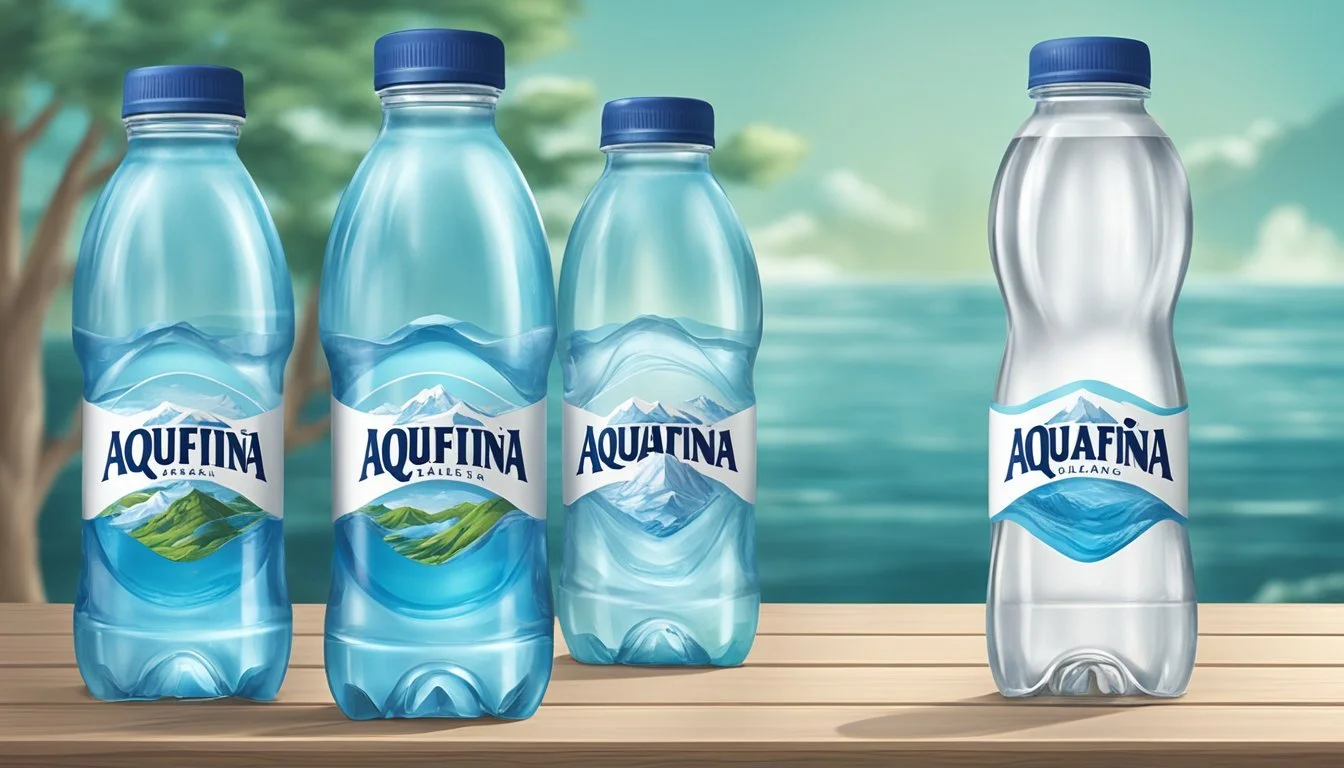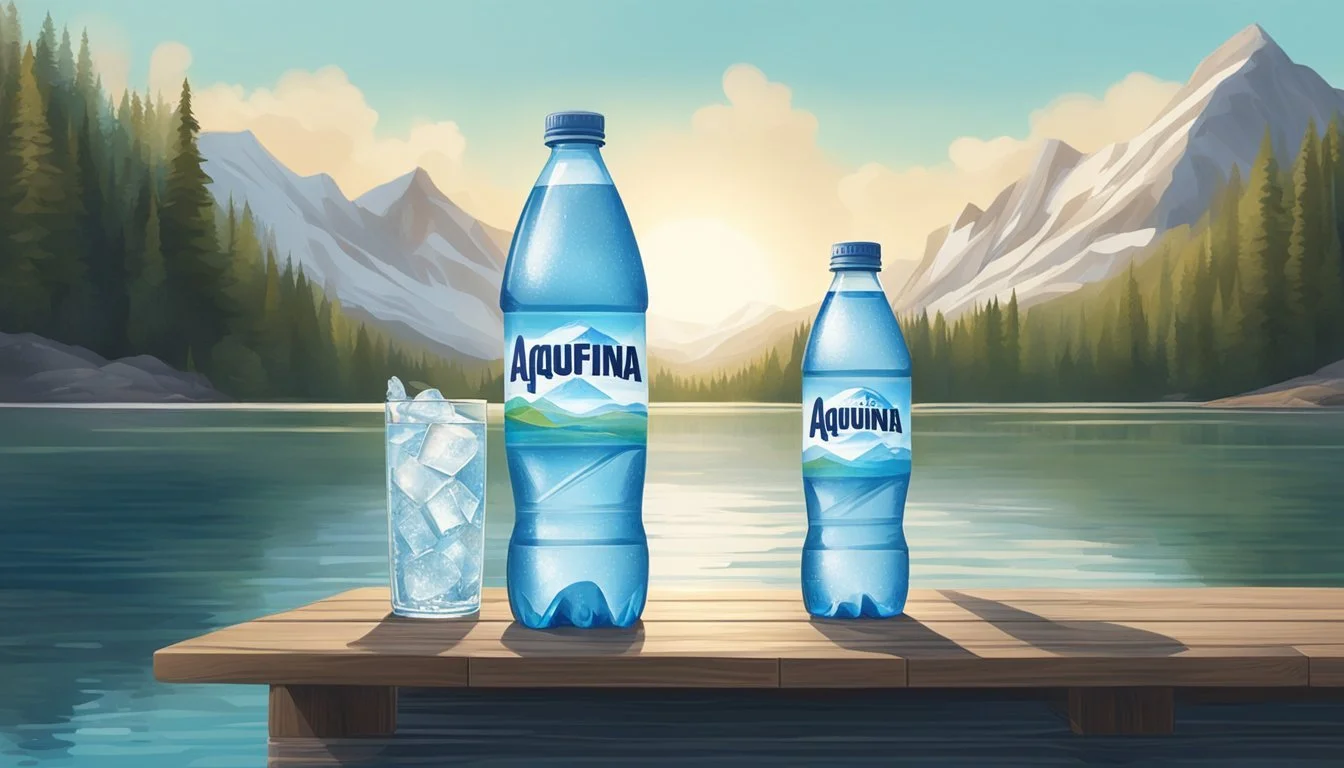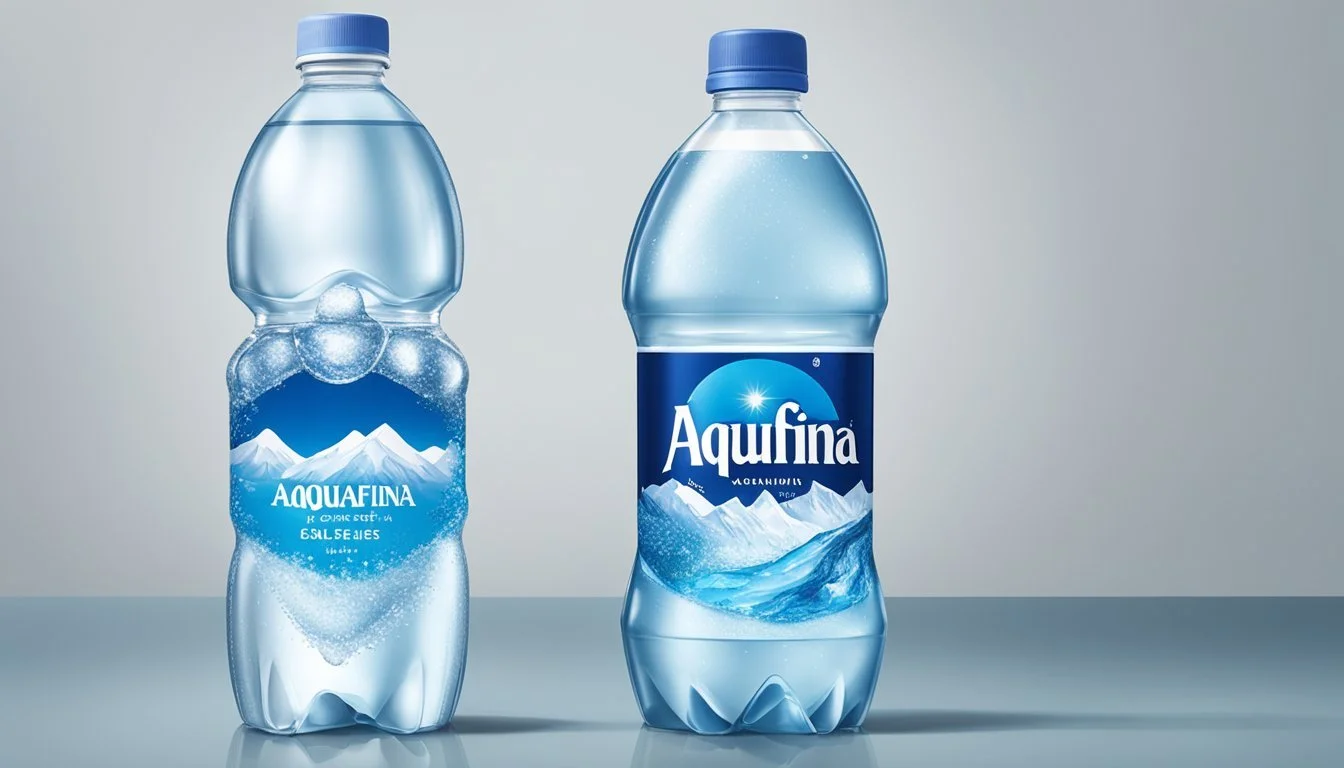Aquafina vs. Icelandic Glacial
A Comparison of Bottled Water Quality
When it comes to bottled water, consumers are faced with an array of choices, each claiming purity, taste, and health benefits. Among the multitude of options, Aquafina and Icelandic Glacial stand out for their market presence and distinct sourcing. Aquafina, a purified bottled water that originates from municipal sources, undergoes a rigorous filtration process that includes reverse osmosis. On the other hand, Icelandic Glacial boasts an exotic origin, being sourced from the Ölfus Spring in Iceland, which is naturally filtered through lava rock and touted for its high pH level and low mineral content.
The contrast between the two brands highlights the varying consumer preferences and values in the bottled water market. While Aquafina prides itself on its purification process that ensures consistent taste and purity, Icelandic Glacial emphasizes its environmental credentials and the natural qualities of its single-source origin. This juxtaposition presents consumers with a choice: opt for the technologically purified and widely available Aquafina, or choose the premium, ecologically conscious water of Icelandic Glacial, which is less available but carries a unique narrative of natural purity.
In evaluating which bottled water is better, it's essential to consider factors such as the purity of the water, the environmental impact of its production, and the taste preferences of different consumers. Some might prefer the accessible and reliably clean taste of Aquafina, while others might lean towards the mineral balance and sustainability ethos of Icelandic Glacial. Each brand's merits reflect the multifaceted nature of consumer demands in the bottled water industry.
Historical Overview
The bottled water industry has witnessed remarkable growth with many brands vying for consumer attention. Among them, Aquafina and Icelandic Glacial have unique histories that mark their entry and establishment in the market.
Origins of Aquafina
Aquafina is a brand of purified bottled water products produced by PepsiCo, which first launched the product in 1994. The brand made its debut in Wichita, Kansas, initially occupying a modest position in the market dominated by several other brands. Aquafina's purification process includes hydro-7™, a trademarked filtration process that PepsiCo claims removes substances other than water molecules. This extensive purification process helped position Aquafina as a notable competitor in the bottled water industry.
Origins of Icelandic Glacial
Icelandic Glacial, meanwhile, originates from Iceland and is sourced from the Ölfus Spring, one of Iceland's most pristine ecosystems. The brand was established in 2004 and marketed as an environmentally friendly and sustainable product. It boasts a high pH level and low mineral content, which gives the water its characteristically clean and fresh taste. Icelandic Glacial takes pride in using geothermal and hydroelectric power to fuel its bottling facility, emphasizing a commitment to carbon neutrality. This eco-conscious approach differentiates Icelandic Glacial from many other brands.
Source and Production
The source and method of production for bottled water significantly influence its quality. Two prominent brands, Aquafina and Icelandic Glacial, showcase unique approaches to sourcing and purifying water.
Aquafina Water Source and Filtration
Aquafina sources its water from public water supplies, a process starting with municipal tap water. The brand employs a thorough filtration process known as HydRO-7™, which is a series of steps that includes sand filtration, carbon filtration, reverse osmosis, and ozonation. The reverse osmosis technique is key, as it removes most dissolved substances from the water, aiming to deliver purity and taste consistency.
Key Steps in Aquafina Filtration:
Sand Filtration
Carbon Filtration
Reverse Osmosis
UV Light Treatment
Ozonation
Icelandic Glacial Water Source and Purity
In contrast, Icelandic Glacial water boasts a natural origin, sourced from the legendary Ölfus Spring in Iceland, formed over 5,000 years ago and replenished by rain and snowmelt infiltrating through volcanic rock. The water naturally filters itself and remains untouched until bottled, which the brand claims preserves its natural balance of minerals and its alkaline pH level. Icelandic Glacial water is distinct for this direct acquisition from a natural spring, avoiding reliance on industrial purification.
Features of Icelandic Glacial Water Source:
Origin: Ölfus Spring
Filtration through volcanic rock
No artificial purification
Naturally occurring minerals
Alkaline pH level
Quality and Health Implications
Choosing between Aquafina and Icelandic Glacial involves analyzing their mineral content, health benefits, and safety concerns to ensure consumers are making informed decisions about their hydration needs.
Comparative Mineral Content
Aquafina, a purified water brand that originated in the United States, boasts a demineralization process that strips out most natural electrolytes and minerals. Consumers who favor mineral intake from their bottled water might consider this a downside. Icelandic Glacial, on the other hand, naturally contains minerals like calcium, magnesium, and potassium, offering a more robust mineral profile helpful for maintaining electrolyte balance.
Hydration and Health Benefits
Both Aquafina and Icelandic Glacial offer hydration, but the presence of naturally occurring minerals and electrolytes in Icelandic Glacial can contribute to better hydration and potential health benefits. These electrolytes are vital for many bodily functions, including maintaining proper hydration levels, which can be advantageous for active individuals seeking optimal performance and recovery.
Contaminants and Safety Concerns
Concerns about contaminants such as heavy metals, PFAS chemicals, fluoride, and microplastics are crucial for bottled water consumers. Aquafina, being thoroughly purified drinking water, typically has these contaminants removed to below detectable levels. Icelandic Glacial is sourced from the Olfus Spring in Iceland and is also known for its purity, boasting low levels of contaminants due to the natural filtration of the spring. Both brands implement rigorous quality controls to ensure safety and compliance with health standards.
Taste and Palatability
When consumers choose bottled water, taste is a primary consideration. Aquafina and Icelandic Glacial offer distinct taste profiles due to their different sources and filtration processes.
Aquafina utilizes a purification system that includes charcoal filtration, reverse osmosis, and other filtering methods. The brand emphasizes its commitment to delivering a pure taste. This extensive purification process aims to remove substances that can affect taste, resulting in a clean and crisp flavor profile. However, some consumers may perceive this level of purification as contributing to a taste that could be described as flat or neutral due to the lack of naturally occurring minerals.
Icelandic Glacial, on the other hand, sources its water from the Ölfus Spring, which is naturally filtered through lava rock, granting it a unique mineral balance. The spring was formed by a volcanic eruption over 5,000 years ago, adding a narrative of natural purity to the brand. The water is touted to have a refreshing taste, which some may attribute to the mineral content and the pH level that is naturally alkaline. In contrast to Aquafina, Icelandic Glacial's taste might be perceived as richer or more robust, which can be appealing to those who favor a taste that reflects the water's natural source.
Comparison in Taste:
Aquafina: Purified, Crisp, Neutral
Icelandic Glacial: Natural, Rich, Mineral-infused
Both brands offer high-quality bottled water, but the choice may come down to individual preference for naturally occurring minerals versus purified neutrality. Those who prefer volcanic naturally filtered water might gravitate towards Icelandic Glacial for its distinct taste, while those valuing purity above all else may find Aquafina's taste to be superior.
Environmental Impact
Selecting bottled water brands often goes beyond taste preferences—their environmental impact is increasingly coming under scrutiny. Consumers are paying attention to the sustainability of the bottling process and how efficiently companies manage recycling and waste.
Bottling Process and Sustainability
Aquafina, traditionally sourced from municipal water supplies, employs purification processes before bottling. Their methods aim to ensure quality, but do not inherently reduce waste from production. However, in the spirit of environmental responsibility, Aquafina has initiated efforts to decrease their carbon footprint and utilize recyclable materials.
Icelandic Glacial, on the other hand, prides itself on its sustainable bottling practices. The water is naturally filtered and bottled at the source in Iceland, tapping into the renewable energy that the country is known for. The brand claims a carbon-neutral footprint due to their sustainable operations, which arguably positions them ahead regarding environmental stewardship.
Use of RPET: Icelandic Glacial has incorporated rPET, recycled polyethylene terephthalate, in their bottles, reducing the demand for new plastic and promoting a circular economy.
Initiatives to Reduce Waste: Both brands are involved in various initiatives to reduce overall waste, though Icelandic Glacial often emphasizes its commitment to sustainability in its marketing.
Recycling and Waste Management
Regarding recycling and waste management, the industry faces challenges. Both Aquafina and Icelandic Glacial produce recyclable bottles, yet the effectiveness of recycling ultimately depends on consumer practices and available municipal recycling facilities.
Recycling Rates: It's important to note that while bottles from both brands are recyclable, actual recycling rates may vary widely based on global regions and local recycling programs.
Boxed water products, though not specifically associated with Aquafina or Icelandic Glacial, have been introduced in the market as an alternative to plastic bottles, proposing that they are more sustainable and have a lower carbon footprint.
Waste Management Initiatives: Both brands are necessitated by law and driven by consumer pressure to engage in waste management efforts, but such initiatives are complex and rely on multifaceted approaches beyond the control of any single company.
Consumer Information
In choosing between Aquafina and Icelandic Glacial bottled waters, consumers must consider label transparency and price, which are pivotal for an informed purchase decision.
Label Transparency and Regulations
Aquafina, sourced from municipal water supplies, adheres to stringent safety regulations enforced by the International Bottled Water Association (IBWA) and the U.S. Food and Drug Administration (FDA). The brand is clear about its purification process, which involves reverse osmosis. Icelandic Glacial, sourced from Iceland's Ölfus Spring, is also bound by IBWA standards, touting its natural purity and sustainable sourcing. Labels include vital information such as source and mineral content, aligning with regulations.
Aquafina:
Source: Municipal water
Treatment: Reverse osmosis
Association: IBWA and FDA regulated
Icelandic Glacial:
Source: Ölfus Spring, Iceland
Treatment: Natural filtration
Certification: CarbonNeutral® product and company
Price Comparison
When comparing prices, Aquafina is generally less expensive than Icelandic Glacial. Reasons for Icelandic Glacial's higher price point include long-distance shipping from Iceland and the perception of it being a premium product. Ryan Felton, an investigative journalist, would agree that water pricing can reflect complicated issues beyond mere production costs, such as branding and marketing.
Typical Prices:
Aquafina: Less expensive due to local sourcing
Icelandic Glacial: More expensive, reflecting its premium market position and international shipping expenses
In summary, both brands offer transparent labeling consistent with IBWA regulations, yet their prices vary due to different source locations and associated costs.
Market Presence and Branding
Aquafina and Icelandic Glacial stand out in the bottled water market due to their distinct branding and international presence. Both brands convey messages of purity and quality, attracting consumers worldwide.
Global Reach and Consumer Trust
Aquafina, owned by PepsiCo, boasts a widespread global reach, similar to its parent company's impressive distribution channels. It is a widely recognized brand among consumers and is readily available across various markets—including supermarkets and vending machines. Icelandic Glacial, while having a more niche market, has carved out a significant presence due to its source of Icelandic spring water, perceived by consumers as premium due to the country's pristine reputation.
Aquafina: Available in over 40 countries.
Icelandic Glacial: Sold in multiple countries and often associated with luxury due to its Icelandic origin.
The trust consumers have in these brands often stems from the perception of water quality and brand reputation. Aquafina aligns itself with the reliability of PepsiCo's other products, while Icelandic Glacial capitalizes on the pure image of Iceland's natural water sources.
Marketing Strategies
The marketing strategies of Aquafina and Icelandic Glacial differ significantly due to their ownership structures and brand images. Aquafina harnesses the robust marketing machinery of PepsiCo, which includes collaborations with large chains such as Starbucks and extensive advertising campaigns. In contrast, Icelandic Glacial tends to focus on highlighting its water's origin and sustainability, aiming to appeal to consumers who prioritize environmental consciousness.
Aquafina's Marketing Highlights:
Partnerships with global entities like Coca-Cola and Starbucks.
Utilizes PepsiCo's extensive marketing and distribution network.
Icelandic Glacial's Marketing Highlights:
Emphasizes eco-friendly bottling and carbon-neutral operation.
Frequently spotlights Iceland's natural beauty in marketing materials to convey the purity and premium nature of the water.
Both brands employ unique branding strategies that resonate with their target demographics, using their respective strengths—global distribution for Aquafina and a clean, sustainable image for Icelandic Glacial—to maintain and expand their market presence.
Product Variants
In competing within the bottled water market, both Aquafina and Icelandic Glacial offer a range of product variants that cater to diverse consumer preferences. From flavored options to different packaging styles, each brand showcases unique selling points.
Flavored and Functional Offerings
Aquafina has expanded beyond its original purified water to include a variety of flavored water options. Flavors such as raspberry, peach, and grape provide consumers with a zero-calorie, sugar-free alternative to sweetened beverages. Additionally, Aquafina introduced Aquafina FlavorSplash, which adds a hint of flavor to the water.
Icelandic Glacial, on the other hand, stands out with its natural alkaline water offerings, emphasizing their product’s high pH level derived from Iceland’s volcanic landscapes. The brand does not heavily focus on flavored waters, instead ensuring that the natural minerals and electrolytes remain the highlight of their product.
Packaging Options
Aquafina provides its water in various plastic bottle sizes. They range from small single-serving bottles to larger multi-serve sizes suitable for family use or events:
Size Packaging Type 12 oz Plastic Bottle 16.9 oz Plastic Bottle 1 Liter Plastic Bottle 1.5 Liter Plastic Bottle
Aquafina's packaging aligns with typical consumer needs for convenience and portability.
Icelandic Glacial differentiates itself with a focus on sustainability, offering their water in both plastic and glass bottles, appealing to environmentally conscious customers. The inclusion of glass bottle options caters to a segment of the market that prefers this for both aesthetic and recycling reasons. They have also introduced a sparkling water line alongside their still water, both available in a variety of bottle sizes:
Size Packaging Type Water Type 500ml Glass Bottle Still / Sparkling 750ml Glass Bottle Still / Sparkling 500ml Plastic Bottle Still / Sparkling 1 Liter Plastic Bottle Still
Icelandic Glacial’s offerings stand out for their premium presentation and commitment to eco-friendly packaging options.
Consumer Reviews and Reputation
In comparing Aquafina and Icelandic Glacial, consumer reviews often serve as a key indicator of their reputations. Aquafina, though a widely recognized brand, receives mixed feedback. Consumers frequently mention its accessibility and affordability, but it seldom stands out in rankings of popular bottled water brands, sometimes positioned as a middle-of-the-road option.
Accessibility: Widely available
Price: Affordable
Rankings: Middle tier
Icelandic Glacial, on the other hand, tends to garner praise for its taste and the source of its water. Boasting a pristine Icelandic origin, it can be more challenging to find. However, it is often listed closer to the top in "worst to best" bottled water rankings, suggesting a positive consumer perception.
Taste: Often praised for richness and refreshment
Source: Icelandic spring water
Availability: Less common than mainstream brands
Both brands have their advocates and critics. Icelandic Glacial's reputation for high quality is balanced by its generally higher price and limited accessibility, while Aquafina's advantage lies in its ubiquity and pricing. These factors contribute significantly to each brand's reputation among consumers.
When comparing the two, it's evident that reviews often reflect the value placed on the origin and purity of the water, alongside practical considerations such as price and availability. Each brand holds a distinct place in the market, shaped by consumer experiences and preferences.
Conclusion
In the comparison of Aquafina and Icelandic Glacial, each presents its strengths catered to distinct consumer preferences. Aquafina, produced by PepsiCo, is purified tap water that undergoes a rigorous filtration process. It boasts a consistent quality and is highly accessible, making it a reliable choice for hydration needs. However, it does not contain the natural minerals that some consumers may seek.
Icelandic Glacial, on the other hand, is a natural spring water known for its purity and is sourced from Iceland's pristine ecosystems. It stands out for its low mineral content and absence of pollutants, offering a taste that reflects its untouched origin. Icelandic Glacial's high quality often attracts consumers who prefer natural mineral waters and are looking for premium hydration options.
Feature Aquafina Icelandic Glacial Source Purified tap water Natural spring water Quality Consistent, highly purified Low mineral content, pure Consumer Preference Widely available, affordable Natural minerals, premium choice
Both brands ensure safety and meet the necessary standards for drinking water, but they cater to different market segments—Aquafina appeals to those seeking purified water, while Icelandic Glacial serves those preferring natural spring water. It's crucial to acknowledge that while preferences may vary, the primary goal of both brands is to provide safe and clean water to their consumers. Issues surrounding bottled water, including environmental impact and comparison to local tap water quality, remain complicated and require consumer awareness and thoughtful consideration.







